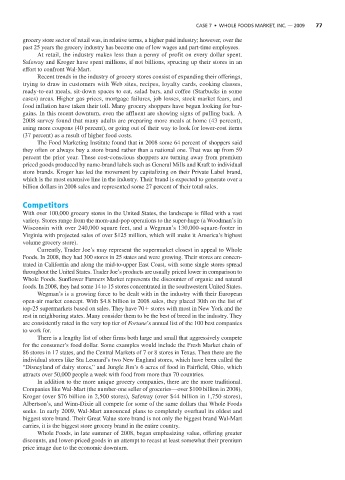Page 481 -
P. 481
CASE 7 • WHOLE FOODS MARKET, INC. — 2009 77
grocery store sector of retail was, in relative terms, a higher paid industry; however, over the
past 25 years the grocery industry has become one of low wages and part-time employees.
At retail, the industry makes less than a penny of profit on every dollar spent.
Safeway and Kroger have spent millions, if not billions, sprucing up their stores in an
effort to confront Wal-Mart.
Recent trends in the industry of grocery stores consist of expanding their offerings,
trying to draw in customers with Web sites, recipes, loyalty cards, cooking classes,
ready-to-eat meals, sit-down spaces to eat, salad bars, and coffee (Starbucks in some
cases) areas. Higher gas prices, mortgage failures, job losses, stock market fears, and
food inflation have taken their toll. Many grocery shoppers have begun looking for bar-
gains. In this recent downturn, even the affluent are showing signs of pulling back. A
2008 survey found that many adults are preparing more meals at home (43 percent),
using more coupons (40 percent), or going out of their way to look for lower-cost items
(37 percent) as a result of higher food costs.
The Food Marketing Institute found that in 2008 some 64 percent of shoppers said
they often or always buy a store brand rather than a national one. That was up from 59
percent the prior year. These cost-conscious shoppers are turning away from premium
priced goods produced by name-brand labels such as General Mills and Kraft to individual
store brands. Kroger has led the movement by capitalizing on their Private Label brand,
which is the most extensive line in the industry. Their brand is expected to generate over a
billion dollars in 2008 sales and represented some 27 percent of their total sales.
Competitors
With over 100,000 grocery stores in the United States, the landscape is filled with a vast
variety. Stores range from the mom-and-pop operations to the super-huge (a Woodman’s in
Wisconsin with over 240,000 square feet, and a Wegman’s 130,000-square-footer in
Virginia with projected sales of over $125 million, which will make it America’s highest
volume grocery store).
Currently, Trader Joe’s may represent the supermarket closest in appeal to Whole
Foods. In 2008, they had 300 stores in 25 states and were growing. Their stores are concen-
trated in California and along the mid-to-upper East Coast, with some single stores spread
throughout the United States. Trader Joe’s products are usually priced lower in comparison to
Whole Foods. Sunflower Farmers Market represents the discounter of organic and natural
foods. In 2008, they had some 14 to 15 stores concentrated in the southwestern United States.
Wegman’s is a growing force to be dealt with in the industry with their European
open-air market concept. With $4.8 billion in 2008 sales, they placed 30th on the list of
top-25 supermarkets based on sales. They have 70 stores with most in New York and the
rest in neighboring states. Many consider them to be the best of breed in the industry. They
are consistently rated in the very top tier of Fortune’s annual list of the 100 best companies
to work for.
There is a lengthy list of other firms both large and small that aggressively compete
for the consumer’s food dollar. Some examples would include the Fresh Market chain of
86 stores in 17 states, and the Central Markets of 7 or 8 stores in Texas. Then there are the
individual stores like Stu Leonard’s two New England stores, which have been called the
“Disneyland of dairy stores,” and Jungle Jim’s 6 acres of food in Fairfield, Ohio, which
attracts over 50,000 people a week with food from more than 70 countries.
In addition to the more unique grocery companies, there are the more traditional.
Companies like Wal-Mart (the number-one seller of groceries—over $100 billion in 2008),
Kroger (over $76 billion in 2,500 stores), Safeway (over $44 billion in 1,750 stores),
Albertson’s, and Winn-Dixie all compete for some of the same dollars that Whole Foods
seeks. In early 2009, Wal-Mart announced plans to completely overhaul its oldest and
biggest store brand. Their Great Value store brand is not only the biggest brand Wal-Mart
carries, it is the biggest store grocery brand in the entire country.
Whole Foods, in late summer of 2008, began emphasizing value, offering greater
discounts, and lower-priced goods in an attempt to recast at least somewhat their premium
price image due to the economic downturn.

